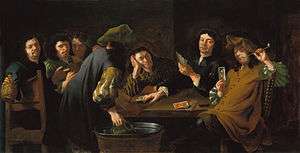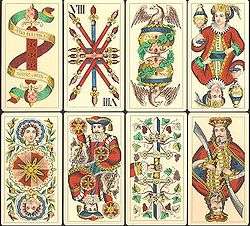Trappola
|
Trappola cards produced in Vienna, Austria, by the card-manufacture Ferdinand Piatnik & Sons. | |
| Origin | Italy |
|---|---|
| Family | Trick-taking |
| Players | 2–4 |
| Skills required | Strategy |
| Cards | 36 |
| Deck | Trappola deck / German deck |
| Play | Clockwise |
| Playing time | 25 min. |
| Random chance | Medium |
Trappola is an early 16th-century Venetian trick-taking card game which spread to most parts of Central Europe and survived, in various forms and under various names like Trapulka, Bulka and Hundertspiel until perhaps the middle of the 20th century. It was played with a special pack of Italian-suited cards derived from the Venetian pattern, and last reported to have been manufactured in Prague in 1944.[1] Piatnik has reprinted their old Trappola deck for collectors.
History of the game
Trappola is an Italian word, which means "trap", mouse trap, cheat, fraud, and with respect to the derivation of the word, Peignot observes that Trappola means an ingenious thing, that is, something which deceives.[2] The earliest version of the game was played without trumps.[3] It is also the earliest known trick-taking game where the ace has been promoted above the king and played with a stripped deck.
Trappola was described by Cardano in his Liber de Ludo Aleae, written in 1564, as a popular Venetian game in the 16th century. It was a very popular card game in Venice in the early 16th century, but somehow appears to have lost its appeal in the area by the end of that century and moved northwards, most probably because of trading and troop movements.
Garzoni calls it the common game, and Tarocco the new invention, quoting the authority of Volaterano.[4] However it is known that Tarocco was once called Trionfi and dates to at least 1440. It is clear that throughout the 17th to 19th centuries the game of Trappola was very popular over a wide area stretching from Nürnberg and Leipzig to Graz and Budapest. Other forms of Trappola, like Špady and Šestadevacet, were popular in the Czechoslovakia before World War II when the last Trappola cards were produced.
A genuine Trappola game, perhaps the only known survivor of the Trappola group is the game Stovkahra, also known as Brčko, played by Romanian Czechs in the village of Șumița, situated in the Banát region of Romania.[5] Players there have resorted to using a 32-card German-suited deck. The reverse game, Coteccio, name applied to various negative point trick games in Italy is reported to be played in Trieste.[6]
Description
The pack
The first actual pack of cards with a maker's name so far discovered was one by Michael Schmit of Buchholz, dated 1646, in the Kümpel collection. Shortly after, in 1664, a pack was made in Prague by the painter Augustin Z-, and bearing the initials H.S.
The 36-card Trappola pack, lacking numerals from three to six, was a specialized version of the Italian pack featuring suits of swords, batons, cups and coins, and the court King, Cavalier and Foot-soldier. The suit signs feature a more elaborate and elegant design than their Italian equivalents, suggesting that Trappola was also a game played by the high society. One of the main features of this pattern are the elongated Cups and Chalices with lids covering them.
This suggests a striking similarity with two distinct features in the history of playing cards: the Trevigiane pattern of north-eastern Italy, and the names of the suits, called Denáry (Coins), Kopy (Cups), Špády (Swords) and Baštony (Batons) in Czech language, all of which loan words borrowed from their Italian counterparts.
Trappola cards are of Venetian origin, according to William Hughes Willshire (1816–99), and result from modifying the 78-card Tarot pack by the suppression of the trumps, and four of the numerals in each suit. They were introduced into Germany at an early date and used there well into the eighteenth century.[7] Later scholars disagree with Willshire pointing out that Trappola decks lack queens unlike tarot decks which always contain four ranks of face cards.[8] A simpler and more logical explanation is that a standard 52-card Venetian deck, which are still being made today, was stripped down to make the 36-card Trappola deck. Tarot and Trappola however did influence each other. Later versions of Trappola borrowed the concept of trumps from Tarot while the latter (in variations played outside of Italy) borrowed the bonus of winning the final trick with the lowest trump.
The deck

The composition of the deck is rather unusual: A K C J 10 9 8 7 2 in each suit. The card values are A=6, K=5, C=4, J=3, with 6 points for the last trick. The other cards have no point value. If the last trick is won with a Deuce, the bonus is doubled to 20 points, which together with the usual 6 makes 26 points.
- Winning the last trick with a two became known as "26".
The rank of the cards
The cards rank from high to low and count as follows:
- A(6)
- K(5)
- C(4)
- J(3)
- 10(null)
- 9(null)
- 8(null)
- 7(null)
- 2(null)
The play

Trappola is a game for 2-players with 9 cards are dealt to each player in batches of four and then five. Non-dealer, if not satisfied with his cards, may discard them face up on the table and take in its place the first nine cards of the stock. If still not satisfied, he may do the same thing again, but must then play with the last nine cards taken from the stock. If he leaves any, the dealer may then exercise the same option either once or twice, depending on how many cards remain. Faced discards may not be taken up during the play.
A player holding three or four Aces, Kings, Queens and Jacks, or Deuces, may declare them any time before playing one of them to a trick, provided that, having only three, he has not already captured the fourth in a trick. He needs to say no more than "three" or "four", as the case may be, unless they are Aces, when he must add "Aces" to his declaration. The appropriate scores are not made until the trick-play is over.
Elder leads to the first trick, and the winner of this trick then leads to the next. Suit must be followe if possible, otherwise any card may be played. A trick is taken by the highest card of the suit led, there being no trump.
A player who wins a trick to a Deuce scores 10 points right at once, and the winner of the last trick scores 6. These are superseded by winning the last one, two, three or four successive tricks with Deuces, the respective compound scores being 26, 52, 78 and 104 points. Each player then adds in the value of counting cards taken in tricks and so finally the value of any three or four card combination declared at the start of the game. The respective scores are:
- Three Aces held before play = 12
- Three Kings held before play = 6
- Three Queens held before play = 6
- Three Jacks held before play = 6
- Three Deuces held before play = 10
- Four Aces held before play = 24
- Four Kings held before play = 12
- Four Queens held before play = 12
- Four Jacks held before play = 12
- Four Deuces held before play = 20
- The score is calculated after each hand and the game continues, and deal passes to the non-dealer, if neither player has reached or exceeded 300 points.
References
- ↑ Oxford Dictionary of Card Games, David Parlett, p. 308 ISBN 0-19-869173-4
- ↑ "Selon le Dictionnaire de la Crusca", le mot Trappola signifie:
cosa ingennese insidia, una sorta di reta,
et trappolatore est la même chose que ingannatore,
giuntarore (trompeur, fripon). D'autres font deriver ce mot de trappe, piergé." - ↑ Parlett, David (1990), The Oxford Guide to Card Games, Oxford University Press, p. 252, ISBN 0-19-214165-1
- ↑ Garzoni Piazza Univenale di Tutte, le Profession del Hondo. Venet. 1589 -
Alcuni altri son giuochi da Taverne come la Mora, le Piastrelle, le Chiave;
e le Carte, o communi, o Tarocchi di nuova inventione, secondo il Volaterrano.
Discorso de 'Giocatori in universal et in particolari, p. 564. - ↑ McCleod, John. Stovkahra at pagat.com. Retrieved 17 July 2015.
- ↑ McCleod, John. Coteccio at pagat.com. Retrieved 17 July 2015.
- ↑ William Hughes Willshire, A Descriptive Catalogue of Playing and Other Cards in the British Museum, pg. 23, Adamant Media Corporation (2001), ISBN 1-4021-7242-7
- ↑ Dummett, Michael (1980). The Game of Tarot. London: Duckworth. pp. Ch. 18.
External links
- McLeod, John, ed., Trappola Group, Card Games Website
